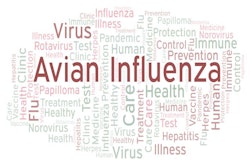
The collection of bacteria, viruses, fungal species and other microorganisms living in the poultry gut, known the gut microbiome, could be the next frontier in fighting foodborne illnesses.
One of the key functions of the gut microbiome is suppressing pathogenic bacteria populations. Understanding how the microbial makeup of the poultry gut impacts and responds to Salmonella infections, and other pathogens, could lead to more effective treatments and preventative measures. This would benefit poultry production, food safety and human as well as bird health.
Salmonella
Salmonella is responsible for approximately 1.35 million illnesses, 26,500 hospitalizations and 420 deaths in the United States each year, according to the Centers for Disease Control and Prevention (CDC). It is also increasingly multi-drug resistant, leading to more severe infections and higher hospitalization rates.
Most Salmonella infections in humans are foodborne in origin, however, poultry can harbor the bacteria without becoming sick.
“Because Salmonella can suppress the poultry natural immune response, Salmonella establishes in young chicks’ intestines and becomes a natural member of the microbiota,” Melha Mellata, an associate professor in the Department of Food Science and Human Nutrition at Iowa State University, said. “This resident Salmonella then may end up in food products like eggs and meat, and even in workers who are in contact with the poultry.”

Resperine
Mellata, and other researchers, are investigating the gut microbiome's role in controlling Salmonella and other potentially harmful bacteria. In the past, antibiotics were used to control Salmonella and other pathogens. Antibiotic use is steadily declining in the U.S. as regulatory and market pressure push farmers away from antimicrobials.
Mellata recently discovered a treatment approach exploiting the linkages between the gut neurochemical and immune systems to help eradicate Salmonella and other harmful bacteria.
“The overall goal of my research is to understand how bacteria, like Salmonella, colonize chickens. I aim to do this by elucidating the complex mechanisms behind host-bacteria interactions,” Mellata said.
The research team found the drug Reserpine, sometimes used to reduce blood pressure in human medicine, reduced the incidence of Salmonella and other potentially harmful bacteria in chicken cells and organs in the laboratory and live birds.
The drug fights Salmonella via an interaction between the chickens’ nervous and immune systems inducing dramatic changes in intestinal immunity and metabolism. This interaction triggers the release of a neurochemical called norepinephrine from the intestinal cells, which then activates an antimicrobial immune response against the pathogen.
“Understanding the mechanisms used by Salmonella to persist in poultry can help guide the development of new strategies,” Mellata said. “Overall, our research will help develop novel strategies to mitigate bacterial infections and antimicrobial resistance deriving from live poultry.”
Natural balance
The sterile design of the modern broiler hatchery could be responsible for the unbalancing of the poultry gut microbiome.
Ivan Rychli, the leader of the Salmonella group and vice director of the Veterinary Research Institute, Brno, Czech Republic, said broiler chicks hatched in hatcheries lack the immediate contact with the adult hen, and the adult hen microbiota, it would receive in nature.

“The hatchery operates well and gives you results, but it interrupts the natural transfer of gut bacteria between the parents and the offspring,” Rychlik said
By understanding which microbiota are commonly transferred from breeder hens to broiler chicks, the team can better determine which bacteria should be included in prebiotic cocktails given to the birds in their first week of life.
In an experiment, broiler chicks inoculated with the bacterial contents of a hen’s gut microbiome before seven days of age were better protected against Salmonella than those that who received the cecal transfer later in life.
Although most of the research into the poultry microbiome so far is gut related, Rychlik said there is much more to learn and explore.
“It’s possible that when we interrupted the contact between hens and chicks in the hatchery, we did not only interrupt the transfer of gut microbiota. We could have also interrupted the transfer of the respiratory tract microbiota, skin microbiota and more,” Rychlik said.
“We still do not know a lot about the microbiota of the intestinal tract, but there is definitely a lot we don’t know about the other microbiomes.”
Whole genome sequencing: A new approach to food safety WATTAgNet.com/articles/43870

















